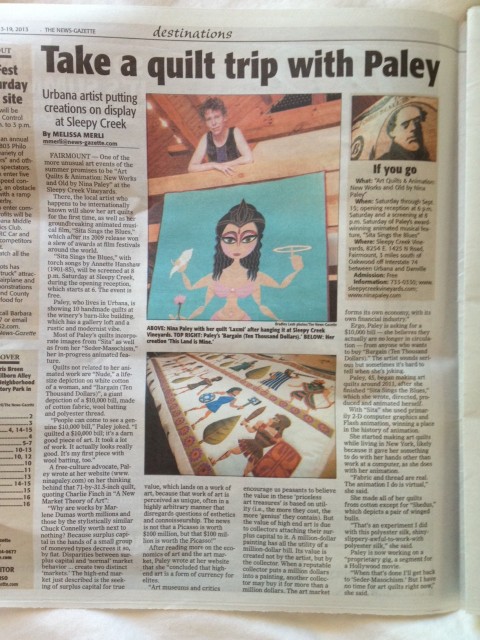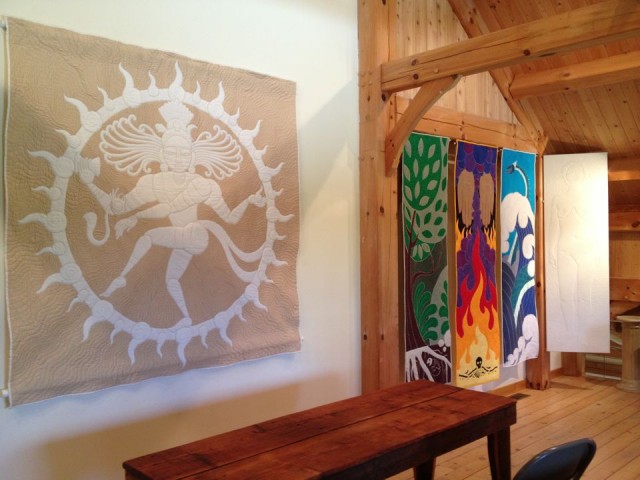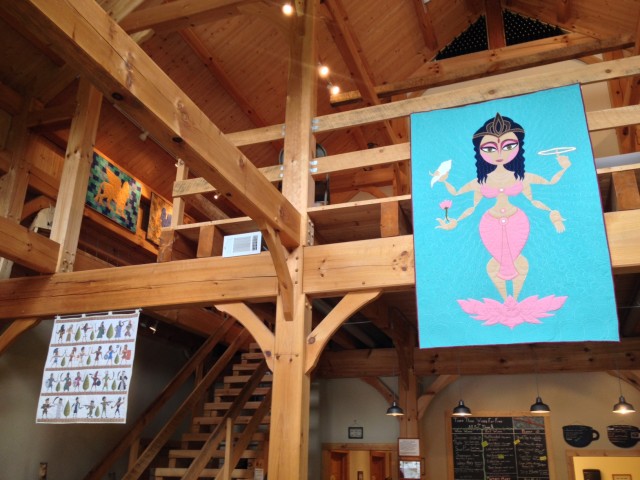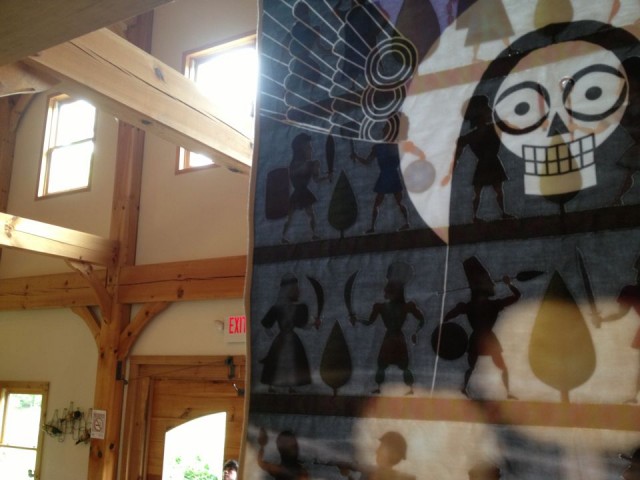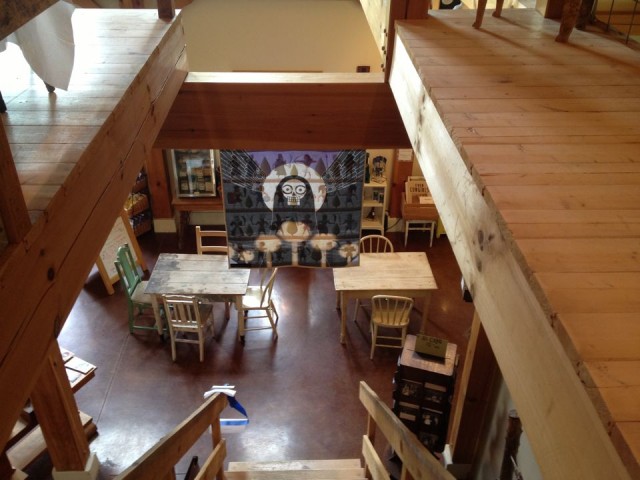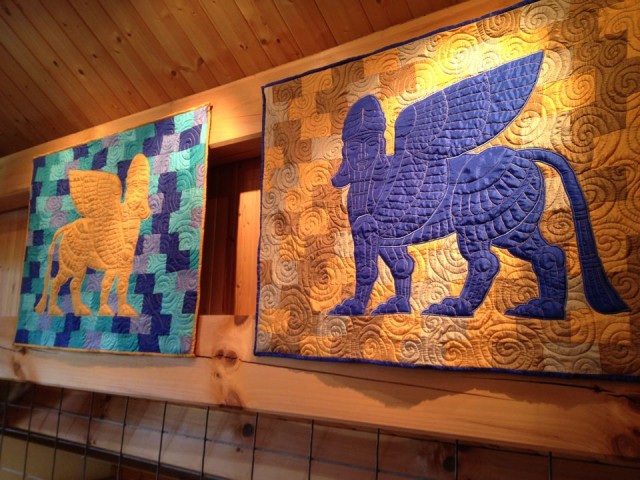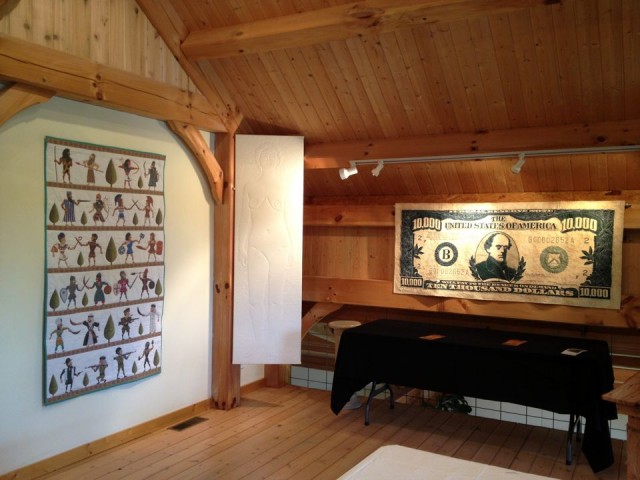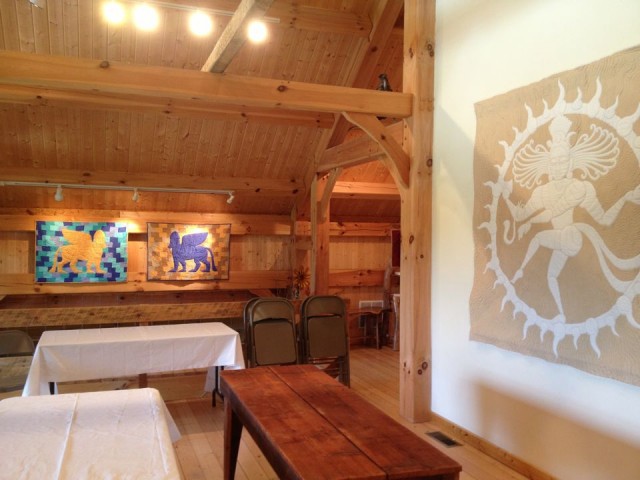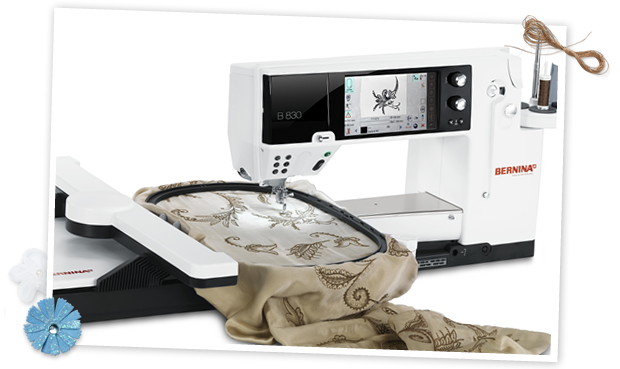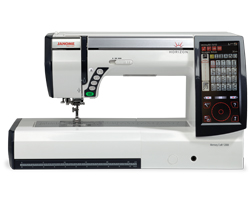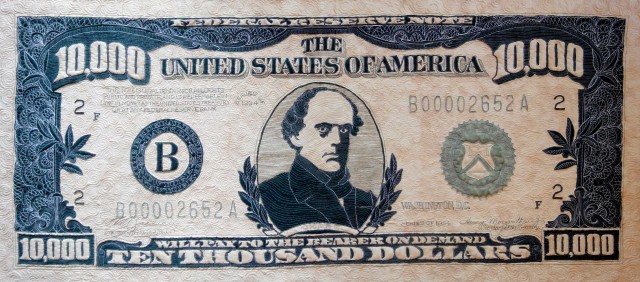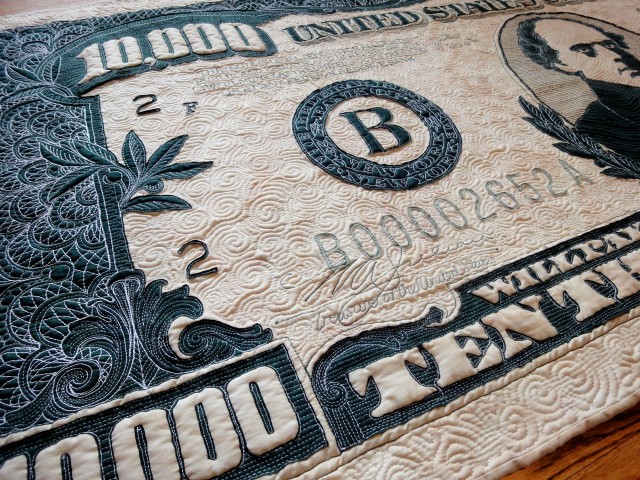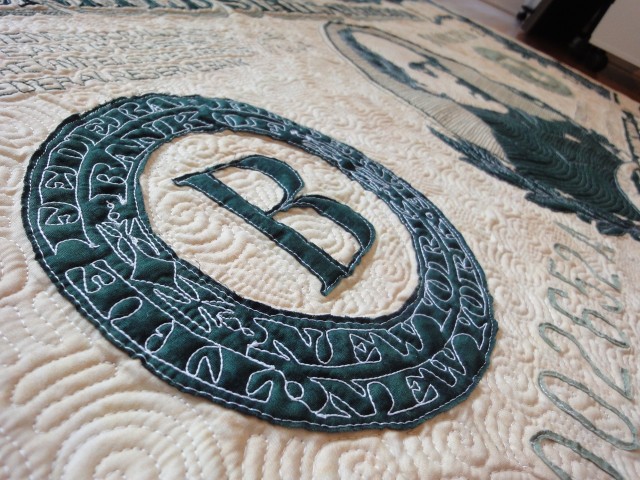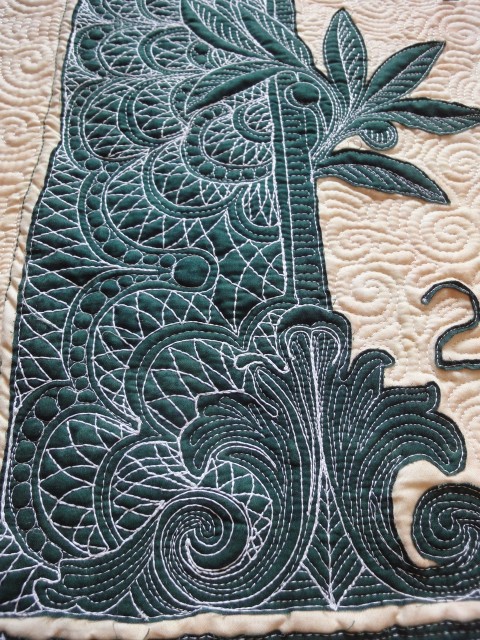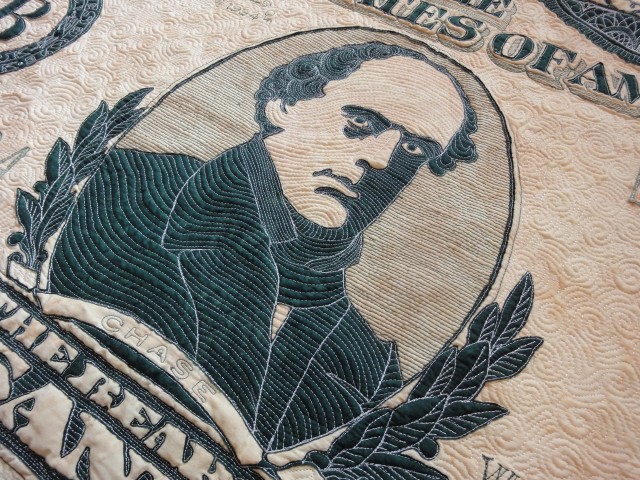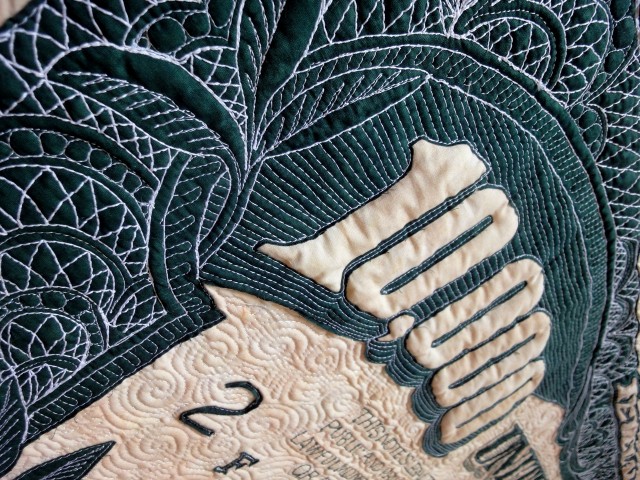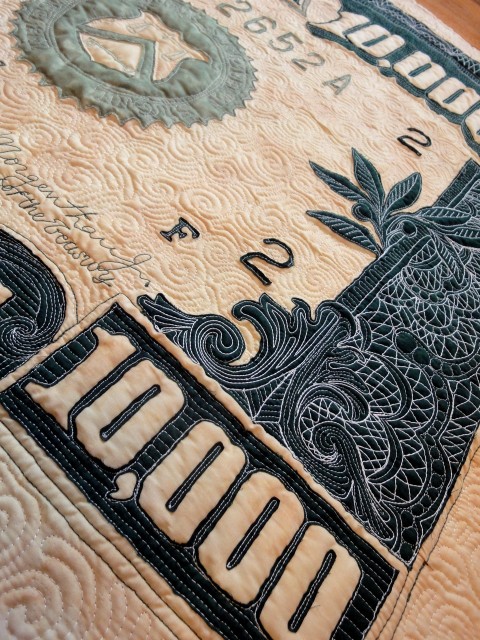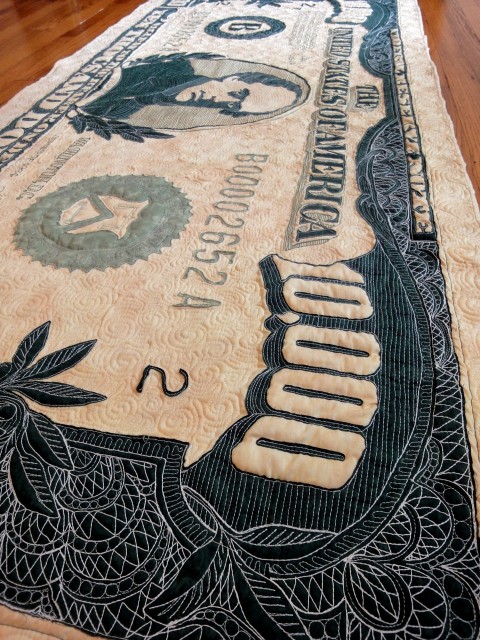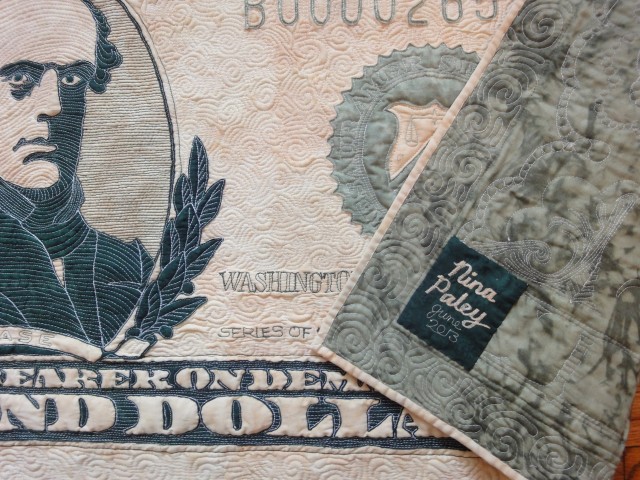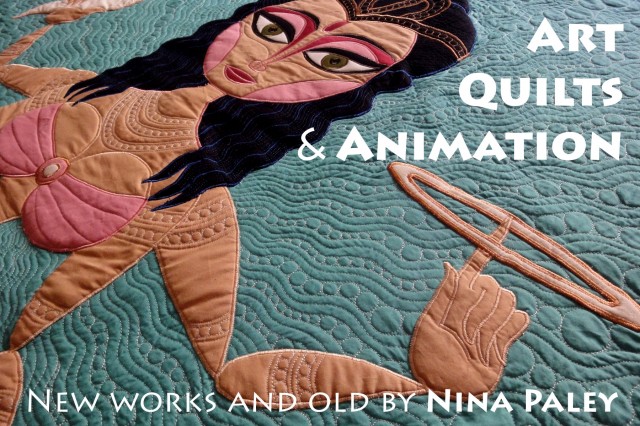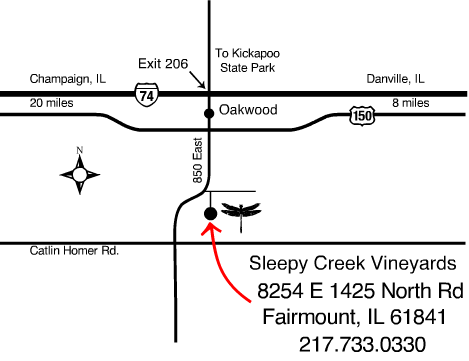That’s me! Getting some local press for my art quilt show, which opens Saturday at Sleepy Creek Vineyards! Details and directions here.
Category: quilting
More Well-Hung
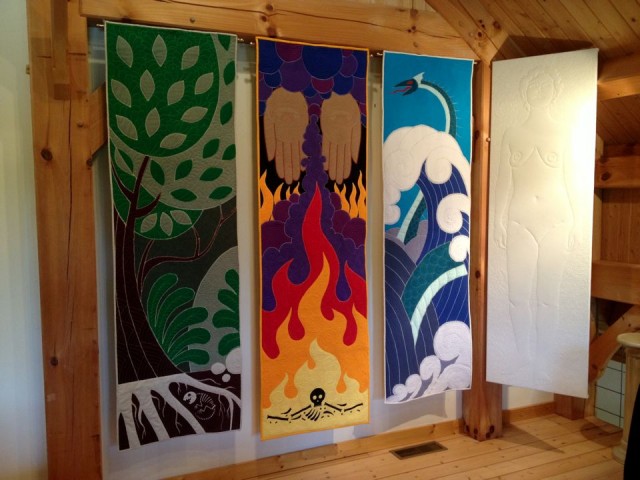 We went back to Sleepy Creek Vineyards to rearrange some things and hang Earth, Fire and Water next to Air/Nude. This is the first time all of my 4 Elements quilts have hung next to each other.
We went back to Sleepy Creek Vineyards to rearrange some things and hang Earth, Fire and Water next to Air/Nude. This is the first time all of my 4 Elements quilts have hung next to each other.
Speaking of Sleepy Creek, I finally tasted their tomato-jalepeño wine, Winey Mary. Yes I thought it was a joke too, but it actually exists and is actually made of fermented tomatoes and jalepeños, not grapes. And I actually liked it. Not as a wine – I don’t really like wine, or beer, or any alcoholic beverages – but as an unusual and strangely tasty sensory experience.
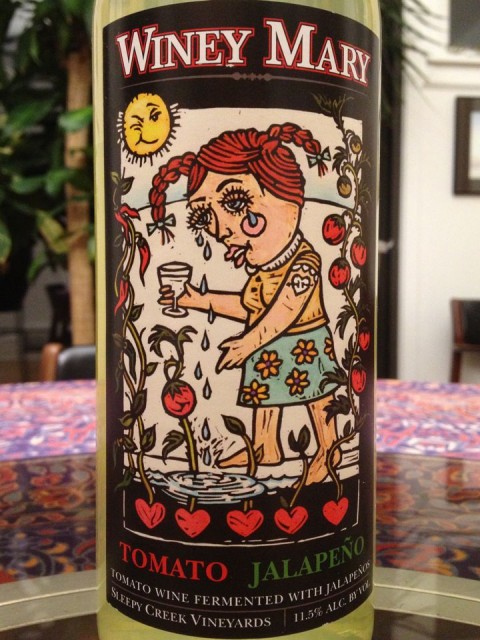 You can try some at the official wine-and-cheese opening (cash bar, buy some local wine!) is this Saturday June 15, with a screening of Sita Sings the Blues at 8pm.
You can try some at the official wine-and-cheese opening (cash bar, buy some local wine!) is this Saturday June 15, with a screening of Sita Sings the Blues at 8pm.
Hangin’ at Sleepy Creek
Today we hung quilts at Sleepy Creek Vineyards. Official wine-and-cheese opening (cash bar, buy some local wine!) is this Saturday June 15. The quilts will be hanging all Summer though.
The small “This Land Is Mine” quilt is double-sided. Here Death watches over the bottom of the stairs. Symbolic?
Bargain (Ten Thousand Dollars) and Nude, along with a larger This Land Is Mine quilt (one-sided)
Shiva Natraj and the Shedus
More at the show – come check it out!
Dear Domestic Embroidery Machine Manufacturers
Your machines are amazing. There is so much I could do with one! I could render a vector-based animated movie, convert each frame into a simple embroidery file, and sew out a frame at a time as a quilt. It would be amazing. I want to do that so much! And your domestic embroidery machines could do it. They are reasonably priced – a few thousand dollars is quite reasonable for a machine that can do that, and many are priced even lower. Such potential! The artist in me is drooling.
But the software. For some reason you sell software for insanely high prices. All I need is software that converts common vector formats (like .eps or .ai) to an embroidery file, and allows me to size it to fit your hoops, and get it into your machine.
To do that would cost me a minimum of $900*. And is Windoze only. Brother’s PE Design NEXT (which is the minimal “level” of software I’d need for my simple vector-to-stitches conversion) appears to cost about $1,000. But I’m not sure – Brother’s web site doesn’t say, and they don’t offer it for sale online, only through “dealers.”
I understand it costs money to develop software for your machines. It also costs money to develop the machines. That’s why you sell the machines. Here’s a tip: The more useful your machines are, the more you will sell! Under the current regime of ridiculous embroidery software prices, you are selling fewer machines. I am not buying your potentially amazing machines because of the software issue. And I really really want an embroidery machine and would be happy to pay many thousands of dollars for one. I’m a ready and eager customer! But no sale.
I would buy one if I could design my own stuff for it.
Imagine a sewing machine that shipped with a limited set of licensed Disney® dress patterns, with a few more online you could download for $5 to $20 each. But sewing your own dress pattern would require expensive proprietary software, closed-source of course so it can’t be improved or debugged or customized. Or how about a sewing machine that uses only proprietary fabric? Which the sewing machine company has a monopoly on, so they sell it for $500 a yard? Sewing machines are popular and diverse because fabric is inexpensive, widely available, and can be used in any machine. The cheaper fabric is, the more sewing machines sell. Expensive proprietary fabric would mean fewer machines would sell. But that is exactly the idiotic business model embroidery machine makers have locked themselves into.
The more useful your machines are, the more you will sell!
Sewing machines are great because you can sew anything with them. Computers are great because you can make anything with them. Computers+automated embroidery machines would be great if you could embroider anything with them, but you can’t. Embroidery software for my Mac is $2,299!
Functional, accessible software makes your machines more valuable. Expensive, restricted software makes them useless.
Let me repeat: functional, accessible software makes your machines more valuable. Expensive, restricted software makes them useless. Which is a pity because they have so much potential.
*P.S. Yes I know there is Embird, which would “only” cost me $309 ($164 basic module + $145 font engine, to convert vector files) to be minimally useful for me (maybe – I can’t even be sure of that). Plus the cost of a PC (which isn’t actually that much because PC manufacturers, unlike embroidery machine manufacturers, know the value of their product increases the more useful it is, and so they encourage lots of software and even support Free Software so they sell lots of PCs, thus driving the price down further even while their manufacturers’ profits increase – think about that!) But Embird only converts EMF, WMF and CMX vector formats, so I’d need yet another program to convert a .eps sequence (or .ai or .swf) first.
There is also this Free svg-to-pcs (Pfaff) converter which I tried with this pcs-to-pes converter a few times and it didn’t work. And also doesn’t have stitch editing or further control. But it is promising.
Even the mighty Linus Torvalds knows about the embroidery software problem, but it’s still not fixed.
Bargain (Ten Thousand Dollars)
Bargain (Ten Thousand Dollars)
71″ x 31.5″
Cotton fabric, wool batting, polyester thread
Reverse applique and quilting
“Why are works by Marlene Dumas worth millions and those by the stylistically similar Chuck Connelly worth next to nothing? Because surplus capital in the hands of a small group of moneyed types decrees it so, by fiat. Disparities between surplus capital and “normal” market behavior…create two distinct “markets.” The high-end market just described is the seeking of surplus capital for true value, which lands on a work of art, because that work of art is perceived as unique, often in a highly arbitrary manner that disregards questions of esthetics and connoisseurship. The news is not that a Picasso is worth $100 million, but that $100 million is worth the Picasso!”
After reading this and this, I concluded that high-end art is a form of currency for elites. Art museums and critics encourage us peasants to believe the value in these “priceless art treasures” is based on utility (i.e., the more they cost, the more “genius” they contain). But the value of high end art is due to collectors attaching their surplus capital to it.
A million-dollar painting has all the utility of a million-dollar bill. Its value is created not by the artist, but by the collector. When a reputable collector puts a million dollars into a painting, another collector may buy it for more than a million dollars. The art market forms its own economy, with its own financial industry:
“During the 1980s, Charles Saatchi started to corner the market by buying up the inventory of one artist, such as Sean Scully, and then dumping the work en masse, presumably for economic gain. Now, collectors such as Daniel Loeb and Aby Rosen also assemble dozens of works by a single artist (Loeb has close to 300 Martin Kippenbergers), but they have so much money that art collecting is a game for them that mimics their larger financial speculations. Using a hedge model, these collectors are able to manipulate the valuations of their holdings based on their internal financial realities, not on any outside demand per se. That is what hedging is.” ibid.
(This explains the prominence of collectors at art events. I used to wonder why collectors were such a big deal. Wasn’t Art about the work itself? If anything came second to the work, wouldn’t it be the artist(s)? Why so much attention bestowed upon the collectors? In my naiveté, I thought it was just cynical and desperate ass-licking by arts organizations. Now I realize that collectors are the prime – or only – originators of high-end art value. Anyone can paint, but only a tiny elite can buy a painting for a million dollars.)
To recap: displaying a million-dollar art work is akin to displaying a million-dollar bill, but with a certain cachet (“disavowal” was Pierre Bourdieu’s term) that is part of its price. But there are no million-dollar bills. That’s one of the reasons collectors need million-dollar paintings. When you own as much wealth as a small nation you can commission your own currency. Or better yet, pick and choose your currency from an enormous market of would-be currency designers. (The 1970’s board game “Masterpiece” hints at this; “value” cards are randomly paired with painting cards, an amusing sendup of the Fine Art World that was utterly lost on me as a child, although I did enjoy looking at the pictures.)
I wanted to make a quilt that looked like a million-dollar bill. Unfortunately the highest denomination bill I could find online at high resolution was $10,000. That’s painfully low, because
“increments of $100,000 are to today’s contemporary art market what $10,000 was in the 1980s and $1,000 was in the ‘60s.” ibid.
But that’s what I had to work with. In fact the $10,000 bill isn’t in circulation today. But it does look like “money” (unlike the $100,000 Gold Certificate) so in that way it fits the bill, so to speak.
Ironically (for ironic juxtaposition!) quilts are among among the most under-valued art forms. They also require more skill and time than almost any other art-making technique I’ve tried. The selling price of quilts seldom covers the costs of materials; quilters often prefer to give their quilts away. An “expensive” quilt usually costs more than the value of materials, but less than minimum wage for labor. I recently met a master quilter whose beautiful wall quilt, which took months of expert work and won many awards, was professionally appraised at $3,500. This is considered very high; had it not been widely displayed and won many awards, it would be “worth” far less. Betty Busby is an art quilter I admire whose works have broken through the “high” end of quilt prices into the “bargain-basement low” end of art prices.
Is it because quilts have so much utility (“use-value”) that they can’t get traction as high art? Is it because quilting is historically “women’s work”? Is it because quilting is often kitschy, popular in the middle-class Midwest that many aspiring art-worlders move to New York to get away from? Is quilting too white? (The now-famous Gee’s Bend quilters would be an exception to prove this rule.) Is it because many quilters are insane about copyright, going out of their way to restrict knowledge of their work?
Who knows. Meanwhile, here is a Ten Thousand Dollar quilt.
P.S. This sucker was a ton of work. The Muse made me do it. A master quilter I ain’t. Quilt appraisers would scoff because I don’t properly tie off and hide my threads, and because there are some puckers and pleats in the quilting. But if I billed the hours I put into this as an animator, I would invoice more than $10,000.
P.P.S. Bargain (Ten Thousand Dollars) will be on display at my upcoming Art Quilt Show at Sleepy Creek Vineyards.
My first solo Art Quilt Show Opens June 15 at Sleepy Creek Vineyards
Mark yer calendars! My first Art Quilt Show opens June 15 at Sleepy Creek Vineyards in hip, happenin’ rural-area-between-Urbana-and-Danville, IL.
Art Quilts will be on the walls June 15-September 15, 2013
Opening: June 15
Reception: 6pm
Screening of Sita Sings the Blues: 8pm
Sleepy Creek Vineyards is three miles south of Oakwood, Illinois, just off Interstate 74 between Danville and Champaign, IL.
Address: 8254 E 1425 North Rd., Fairmount, IL 61841
Phone: 217-733-0330
Directions
Want to see the place? Sleepy Creek has a funny webseries you can watch right now! My favorite is episode 6, it cracks me up.

